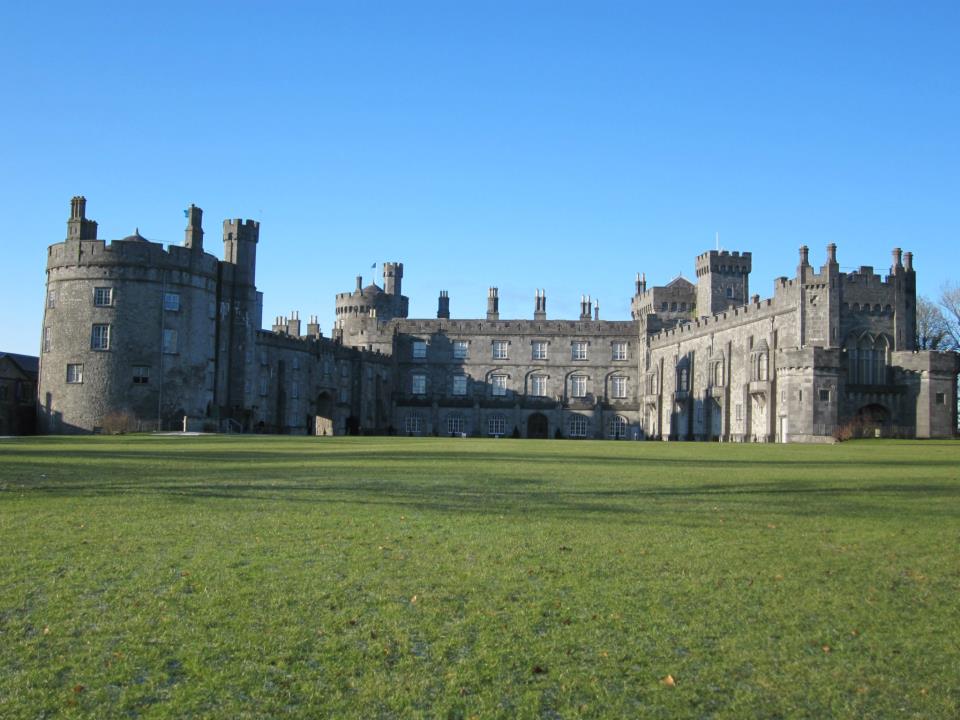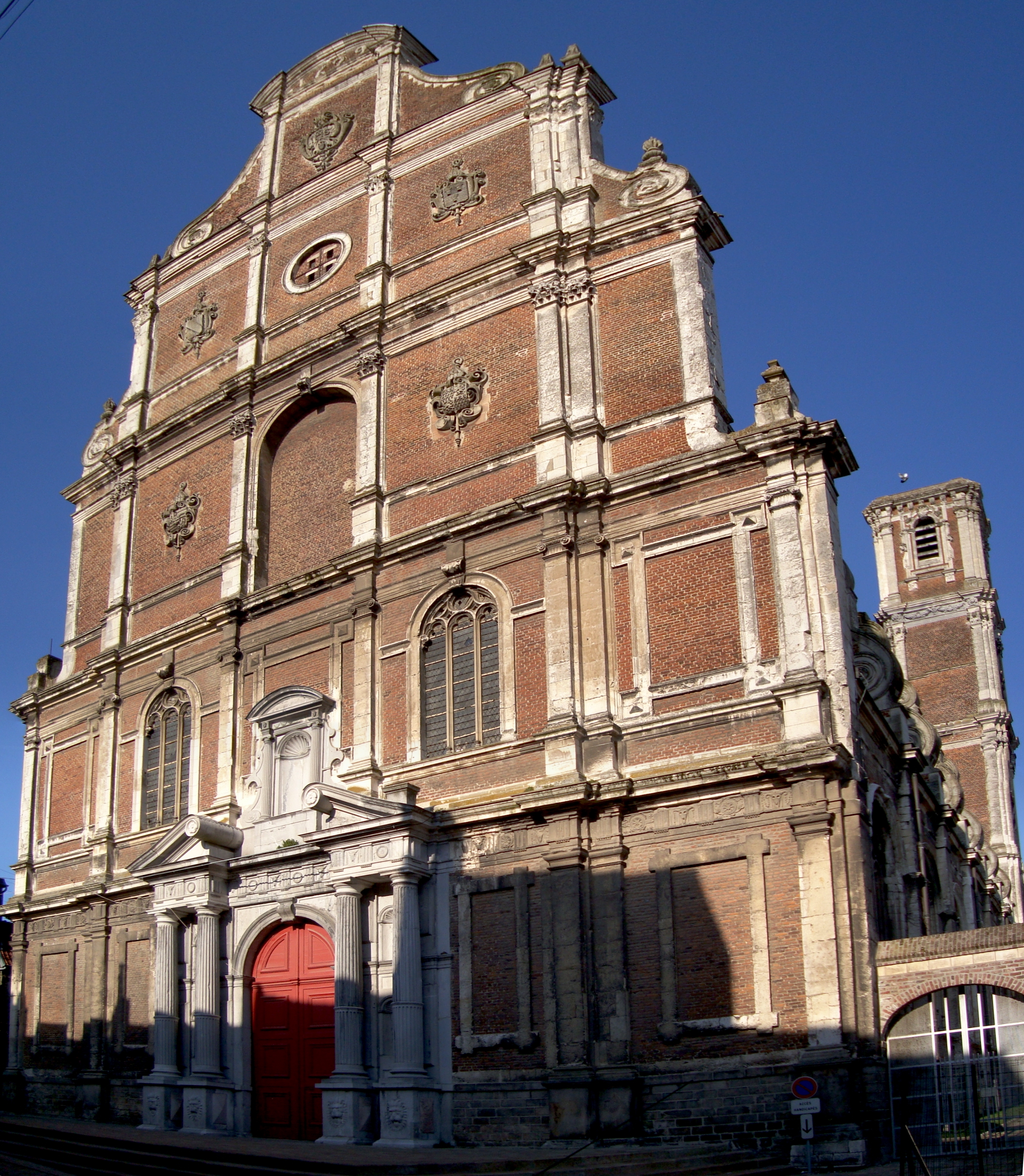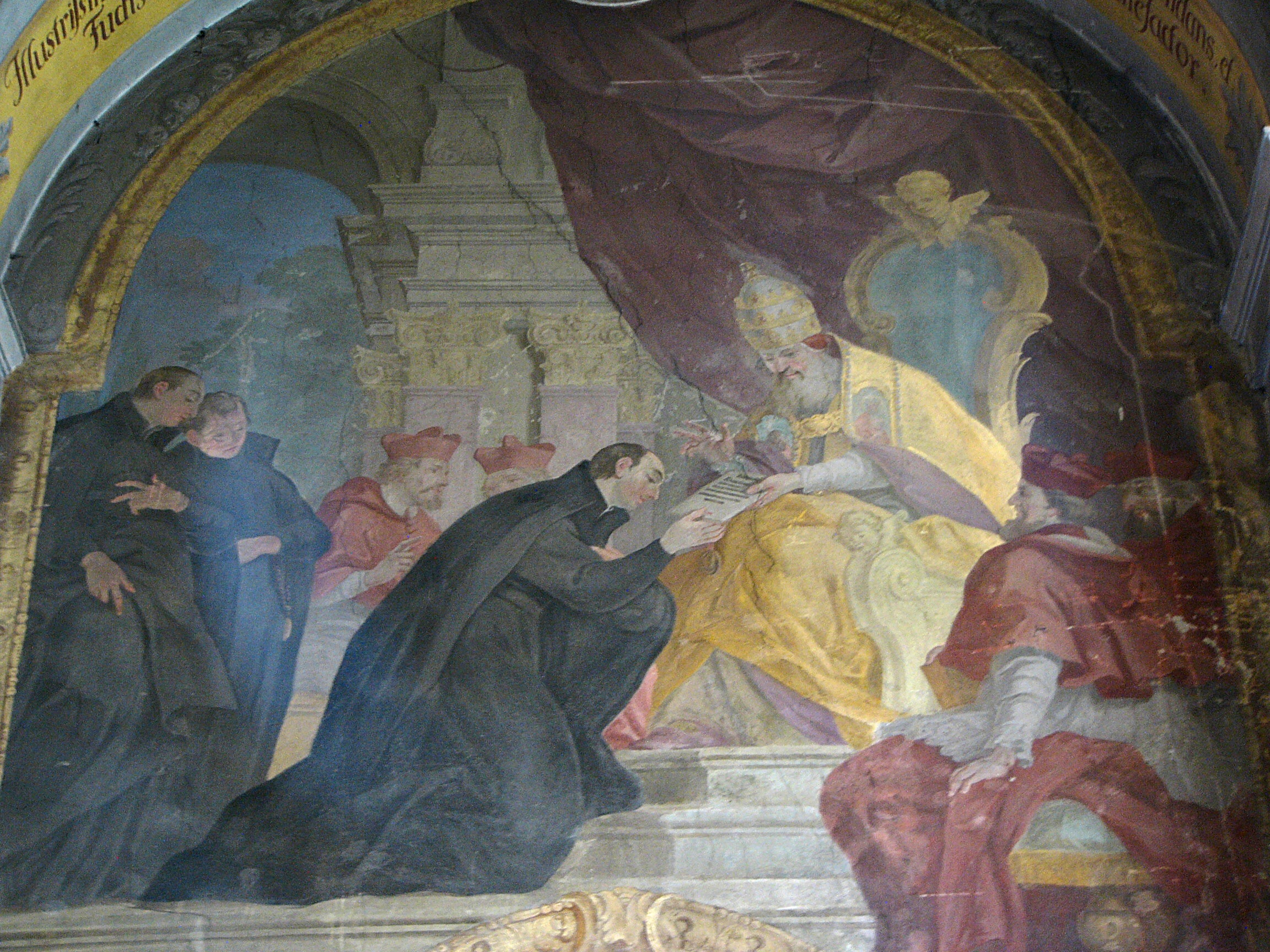|
Christopher Grene
Christopher Grene (1629–1697), was a Jesuit priest. Grene was the son of George Grene, by his wife Jane Tempest, and brother of Father Martin Grene. He was born in 1629 in the diocese of Kilkenny, Ireland, whither his parents, who were natives of England, and belonged to the middle class, had retired on account of the persecution. He made his early studies in Ireland; entered in 1642 the college of the English Jesuits at Liege, where he lived for five years; was admitted into the English College at Rome for his higher course in 1647; was ordained priest in 1653; and sent to England in 1654. He entered the Society of Jesus 7 September 1658, and was professed of the four vows 2 February 1668–9. He became English penitentiary first at Loreto, and afterwards at St. Peter's, Rome. In 1692 he was appointed spiritual director at the English College, Rome, and he died there on 11 November 1697. He rendered great service to historical students by collecting the scattered record ... [...More Info...] [...Related Items...] OR: [Wikipedia] [Google] [Baidu] |
Jesuit
The Society of Jesus ( la, Societas Iesu; abbreviation: SJ), also known as the Jesuits (; la, Iesuitæ), is a religious order (Catholic), religious order of clerics regular of pontifical right for men in the Catholic Church headquartered in Rome. It was founded in 1540 by Ignatius of Loyola and six companions, with the approval of Pope Paul III. The society is engaged in evangelization and apostolic ministry in 112 nations. Jesuits work in education, research, and cultural pursuits. Jesuits also give retreats, minister in hospitals and parishes, sponsor direct social and humanitarian ministries, and promote Ecumenism, ecumenical dialogue. The Society of Jesus is consecrated under the patron saint, patronage of Madonna della Strada, a title of the Blessed Virgin Mary, and it is led by a Superior General of the Society of Jesus, Superior General. The headquarters of the society, its Curia, General Curia, is in Rome. The historic curia of Ignatius is now part of the attached to t ... [...More Info...] [...Related Items...] OR: [Wikipedia] [Google] [Baidu] |
Martin Grene
Martin Grene (1616–1667), was an English Jesuit. Grene, son of George Grene, probably a member of one of the Yorkshire families of the name, by his wife Jane Tempest, is said by Southwell to have been born in 1616 at Kilkenny in Ireland, to which country his parents had retired from their native land on account of the persecution; but the provincial's returns of 1642 and 1655 expressly vouch for his being a native of Kent. He was the elder brother of Christopher Grene. After studying humanities in the college of the English Jesuits at St. Omer, he was admitted to the society in 1638. In 1642 he was a professor in the college at Liege, and he held important offices in other establishments belonging to the English Jesuits on the continent. In 1653 he was stationed in Oxfordshire. He was solemnly professed of the four vows on 3 December 1654. After passing twelve years on the mission he was recalled to Watten, near Saint-Omer Saint-Omer (; vls, Sint-Omaars) is a commune a ... [...More Info...] [...Related Items...] OR: [Wikipedia] [Google] [Baidu] |
Kilkenny
Kilkenny (). is a city in County Kilkenny, Ireland. It is located in the South-East Region and in the province of Leinster. It is built on both banks of the River Nore. The 2016 census gave the total population of Kilkenny as 26,512. Kilkenny is a tourist destination, and its environs include historic buildings such as Kilkenny Castle, St Canice's Cathedral and round tower, Rothe House, Shee Alms House, Black Abbey, St. Mary's Cathedral, Kilkenny Town Hall, St. Francis Abbey, Grace's Castle, and St. John's Priory. Kilkenny is also known for its craft and design workshops, the Watergate Theatre, public gardens and museums. Annual events include Kilkenny Arts Festival, the Cat Laughs comedy festival and music at the Kilkenny Roots Festival. Kilkenny began with an early 6th-century ecclesiastical foundation within the Kingdom of Ossory. Following the Norman invasion of Ireland, Kilkenny Castle and a series of walls were built to protect the burghers of what became ... [...More Info...] [...Related Items...] OR: [Wikipedia] [Google] [Baidu] |
Colleges Of St Omer, Bruges And Liège
The Colleges of St Omer, Bruges and Liège were successive expatriate institutions for Roman Catholic higher education run by the Jesuits for English students. Founded in 1593 by Father Robert Parsons SJ as the College of Saint-Omer in Artois (then part of the Spanish Netherlands),Robert Parsons '' Catholic Encyclopaedia'' (1913). Retrieved 9 July 2008 in the 18th century the college was twice forced to relocate, due to the suppression of the Jesuit order in France. In 1762 most masters and students moved to and in 1773 on to Liège, leaving a smaller college surviving in St Omer. In 1774, th ... [...More Info...] [...Related Items...] OR: [Wikipedia] [Google] [Baidu] |
Liège
Liège ( , , ; wa, Lîdje ; nl, Luik ; german: Lüttich ) is a major city and municipality of Wallonia and the capital of the Belgian province of Liège. The city is situated in the valley of the Meuse, in the east of Belgium, not far from borders with the Netherlands ( Maastricht is about to the north) and with Germany (Aachen is about north-east). In Liège, the Meuse meets the river Ourthe. The city is part of the ''sillon industriel'', the former industrial backbone of Wallonia. It still is the principal economic and cultural centre of the region. The municipality consists of the following districts: Angleur, , Chênée, , Grivegnée, Jupille-sur-Meuse, Liège, Rocourt, and Wandre. In November 2012, Liège had 198,280 inhabitants. The metropolitan area, including the outer commuter zone, covers an area of 1,879 km2 (725 sq mi) and had a total population of 749,110 on 1 January 2008. [...More Info...] [...Related Items...] OR: [Wikipedia] [Google] [Baidu] |
English College At Rome
The Venerable English College (), commonly referred to as the English College, is a Catholic seminary in Rome, Italy, for the training of priests for England and Wales. It was founded in 1579 by William Allen on the model of the English College, Douai. The current Rector is Rev. Stephen Wang from the Diocese of Westminster. History St Thomas' Hospice (1362–1579) The English Hospice of the Most Holy Trinity and St Thomas was founded in the Regola quarter of Rome in 1362 when the English community in Rome purchased a house from the rosary sellers John and Alice Shephard. The Jubilee Year of 1350, which had seen the influx of over a million pilgrims anxious to gain the Plenary Indulgence offered by Pope Clement VI, had exposed the notorious shortcomings of accommodation in the Eternal City. English pilgrims had paid extortionate prices to stay in damp and filthy hostels far from St Peter's Basilica and the Holy Door through which they had come to pass. Innkeepers gave rooms d ... [...More Info...] [...Related Items...] OR: [Wikipedia] [Google] [Baidu] |
Society Of Jesus
, image = Ihs-logo.svg , image_size = 175px , caption = ChristogramOfficial seal of the Jesuits , abbreviation = SJ , nickname = Jesuits , formation = , founders = , founding_location = , type = Order of clerics regular of pontifical right (for men) , headquarters = Generalate:Borgo S. Spirito 4, 00195 Roma-Prati, Italy , coords = , region_served = Worldwide , num_members = 14,839 members (includes 10,721 priests) as of 2020 , leader_title = Motto , leader_name = la, Ad Majorem Dei GloriamEnglish: ''For the Greater Glory of God'' , leader_title2 = Superior General , leader_name2 = Fr. Arturo Sosa, SJ , leader_title3 = Patron saints , leader_name3 = , leader_title4 = Ministry , leader_name4 = Missionary, educational, literary works , main_organ = La Civiltà Cattolic ... [...More Info...] [...Related Items...] OR: [Wikipedia] [Google] [Baidu] |
Loreto, Marche
Loreto ( , , ) is a hill town and ''comune'' of the Italian province of Ancona, in the Marche. It is most commonly known as the seat of the Basilica della Santa Casa, a popular Catholic pilgrimage site. Location Loreto is located above sea level on the right bank of the Musone river and by rail south-southeast of Ancona; like many places in the Marche, it provides good views from the Apennines to the Adriatic. Main sights The city's main monuments occupy the four sides of the piazza: the college of the Jesuits; the Palazzo Comunale (formerly the Palazzo Apostolico), designed by Bramante, that houses an art gallery with works of Lorenzo Lotto, Vouet and Annibale Carracci as well as a collection of maiolica, and the Shrine of the Holy House (''Santuario della Santa Casa''). It also boasts a massive line of walls, designed by the architect (and military engineer) Antonio da Sangallo the Younger, which were erected from 1518 and reinforced in the 17th century. Gallery Fi ... [...More Info...] [...Related Items...] OR: [Wikipedia] [Google] [Baidu] |
English College, Rome
The Venerable English College (), commonly referred to as the English College, is a Catholic seminary in Rome, Italy, for the training of priests for England and Wales. It was founded in 1579 by William Allen on the model of the English College, Douai. The current Rector is Rev. Stephen Wang from the Diocese of Westminster. History St Thomas' Hospice (1362–1579) The English Hospice of the Most Holy Trinity and St Thomas was founded in the Regola quarter of Rome in 1362 when the English community in Rome purchased a house from the rosary sellers John and Alice Shephard. The Jubilee Year of 1350, which had seen the influx of over a million pilgrims anxious to gain the Plenary Indulgence offered by Pope Clement VI, had exposed the notorious shortcomings of accommodation in the Eternal City. English pilgrims had paid extortionate prices to stay in damp and filthy hostels far from St Peter's Basilica and the Holy Door through which they had come to pass. Innkeepers gave rooms ... [...More Info...] [...Related Items...] OR: [Wikipedia] [Google] [Baidu] |
Stonyhurst
Stonyhurst is the name of a rural estate owned by the Society of Jesus near Clitheroe in Lancashire, England. It is centred on Stonyhurst College, occupying the great house, its preparatory school Stonyhurst Saint Mary's Hall and the parish church, St Peter's. The Estate The grounds are bounded by the River Hodder, the village of Hurst Green and Longridge Fell. The Forest of Bowland Area of Outstanding Natural Beauty overlaps in places. The earliest deed for the estate dates back to 1200 A.D. when it was known as the "Stanihurst".A Stonyhurst Handbook for Visitors and Others, third edition, 1963 It passed through the Bayley family to their descendants, the Shireburns ("Sherburnes" etc), before passing into the hands of Thomas Weld (of Lulworth). Already possessing a large estate, he donated it to the Jesuits in 1794 as a new home for their school, of which he was an old boy when it was located at Liège. A junior branch of the Sherburnes, who had earlier fled to Oxford ... [...More Info...] [...Related Items...] OR: [Wikipedia] [Google] [Baidu] |
Oscott
Oscott is a ward in the northwest of Birmingham, England, within the formal district of Perry Barr. The Ward is centred on the area known as Old Oscott, originally just "Oscott", and should not be confused with nearby New Oscott. It includes the former Booths Farm sand quarry, Aldridge Road Recreation Ground, and Kingstanding Circle. The ward borders the Metropolitan Borough of Walsall and areas such as Perry Beeches and Queslett Queslett is an area of Great Barr, Birmingham, England. The name (originally Quieslade) has been in use since the 16th century. The first part, from "Queest", means a wood pigeon, the second comes from the Anglo-Saxon "slade", for a small valle .... Parts fall within Great Barr. The nearest library serving the ward iKingstanding Library History The area is mainly a housing estate built in the 1930s and 1940s. Before that time, it was mainly rural farmland. * Keith Linnecor, - Labour Councillor for Oscott Ward for 25 years until his deat ... [...More Info...] [...Related Items...] OR: [Wikipedia] [Google] [Baidu] |
Westminster
Westminster is an area of Central London, part of the wider City of Westminster. The area, which extends from the River Thames to Oxford Street, has many visitor attractions and historic landmarks, including the Palace of Westminster, Buckingham Palace, Westminster Abbey, Westminster Cathedral and much of the West End of London, West End shopping and entertainment district. The name ( ang, Westmynstre) originated from the informal description of the abbey church and royal peculiar of St Peter's (Westminster Abbey), west of the City of London (until the English Reformation there was also an Eastminster, near the Tower of London, in the East End of London). The abbey's origins date from between the 7th and 10th centuries, but it rose to national prominence when rebuilt by Edward the Confessor in the 11th. Westminster has been the home of Governance of England, England's government since about 1200, and from 1707 the Government of the United Kingdom. In 1539, it became a city ... [...More Info...] [...Related Items...] OR: [Wikipedia] [Google] [Baidu] |







